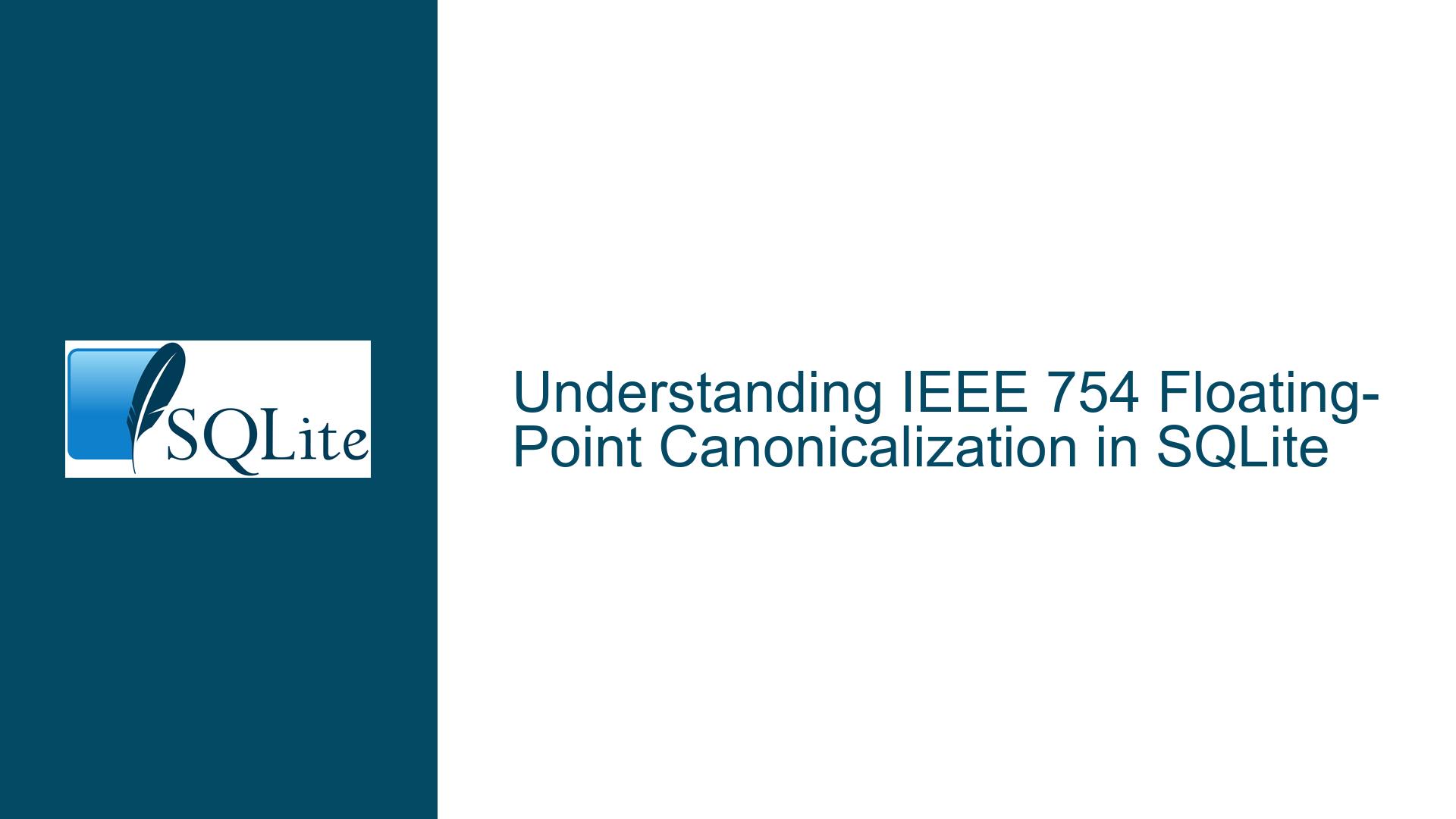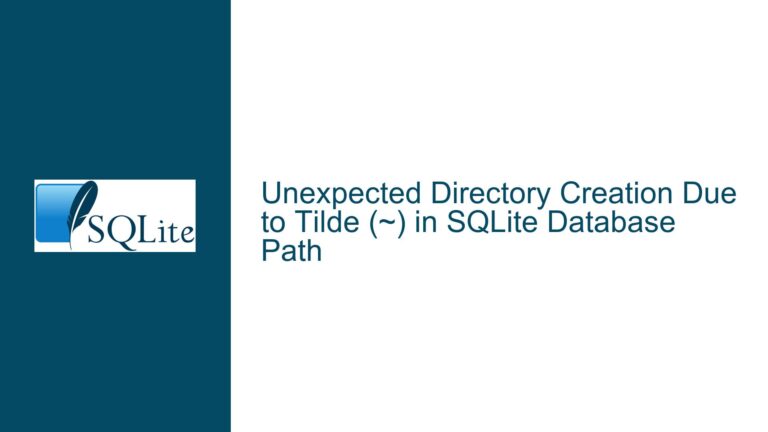IEEE 754 Floating-Point Canonicalization in SQLite
SQLite’s Reliance on IEEE 754 Floating-Point Representation
SQLite, as a lightweight and portable database engine, relies heavily on the IEEE 754 standard for floating-point arithmetic. This standard defines the format for representing floating-point numbers in binary, ensuring consistency across different hardware architectures. SQLite assumes that the underlying CPU supports IEEE 754 doubles, which means that the database engine does not need to perform any additional encoding or decoding of floating-point values. Instead, SQLite simply stores these values in a big-endian format, ensuring that the data remains portable across different systems.
The IEEE 754 standard specifies the representation of floating-point numbers in 32-bit (single precision) and 64-bit (double precision) formats. SQLite uses the 64-bit double-precision format for storing floating-point numbers. This format consists of three parts: the sign bit, the exponent, and the significand (also known as the mantissa). The sign bit determines whether the number is positive or negative, the exponent represents the power of two by which the significand is multiplied, and the significand contains the significant digits of the number.
SQLite’s reliance on the IEEE 754 standard means that it does not need to implement any custom logic for handling floating-point numbers. Instead, it delegates this responsibility to the CPU, which is expected to perform all floating-point operations in compliance with the IEEE 754 standard. This approach simplifies the implementation of SQLite and ensures that floating-point numbers are handled consistently across different platforms.
However, this reliance on the CPU also means that SQLite is vulnerable to any inconsistencies or bugs in the hardware’s implementation of the IEEE 754 standard. For example, the Pentium FDIV bug, which affected some Intel Pentium processors in the mid-1990s, caused incorrect results for certain floating-point division operations. While such issues are rare, they can still have an impact on the accuracy of floating-point calculations in SQLite.
The Role of Big-Endian Format in SQLite’s Floating-Point Storage
One of the key aspects of SQLite’s handling of floating-point numbers is its use of the big-endian format for storing these values on disk. The big-endian format stores the most significant byte of a multi-byte value at the lowest memory address, while the little-endian format stores the least significant byte at the lowest memory address. By using the big-endian format, SQLite ensures that floating-point numbers are stored in a consistent manner across different systems, regardless of the native endianness of the CPU.
This approach is particularly important for ensuring the portability of SQLite databases. Since SQLite databases are often moved between different systems with different architectures, it is crucial that the data remains consistent and interpretable across these systems. By standardizing on the big-endian format, SQLite avoids potential issues that could arise from differences in endianness between systems.
The big-endian format also simplifies the process of reading and writing floating-point values to and from disk. Since the format is consistent, SQLite can simply read or write the bytes of a floating-point number in the order they are stored, without needing to perform any additional byte-swapping operations. This reduces the complexity of the code and improves the performance of floating-point operations in SQLite.
However, the use of the big-endian format does introduce some challenges when working with systems that use the little-endian format. In such cases, SQLite must perform byte-swapping operations to convert between the big-endian format used for storage and the little-endian format used by the CPU. While these operations are relatively simple, they do add some overhead to the process of reading and writing floating-point values.
Potential Issues with Floating-Point Calculations in SQLite
While SQLite’s reliance on the IEEE 754 standard and the big-endian format ensures consistency and portability, it does not guarantee the accuracy of floating-point calculations. Floating-point arithmetic is inherently prone to rounding errors and precision issues, which can lead to unexpected results in certain cases. These issues are not unique to SQLite but are a fundamental aspect of floating-point arithmetic in general.
One common issue with floating-point calculations is the loss of precision when performing operations on numbers with very large or very small magnitudes. For example, adding a very small number to a very large number may result in the small number being effectively ignored due to the limited precision of the floating-point format. This can lead to inaccuracies in calculations, particularly when dealing with financial or scientific data where precision is critical.
Another issue is the potential for rounding errors when converting between decimal and binary floating-point representations. Since most decimal fractions cannot be represented exactly in binary, rounding errors can occur when converting between these representations. These errors can accumulate over multiple operations, leading to significant discrepancies in the final result.
In addition to these general issues, SQLite’s reliance on the CPU for floating-point calculations means that it is subject to any quirks or bugs in the hardware’s implementation of the IEEE 754 standard. For example, the Pentium FDIV bug mentioned earlier caused incorrect results for certain floating-point division operations, which could have affected the accuracy of calculations in SQLite if the database was running on an affected processor.
To mitigate these issues, it is important to be aware of the limitations of floating-point arithmetic and to design applications accordingly. This may involve using alternative data types, such as integers or fixed-point decimals, for calculations where precision is critical. Additionally, it may be necessary to perform additional checks and validations to ensure the accuracy of floating-point calculations in SQLite.
Troubleshooting Floating-Point Issues in SQLite
When troubleshooting floating-point issues in SQLite, the first step is to identify the source of the problem. This may involve examining the data being stored, the operations being performed, and the hardware on which the database is running. In some cases, the issue may be related to the inherent limitations of floating-point arithmetic, while in other cases, it may be due to a bug or inconsistency in the hardware’s implementation of the IEEE 754 standard.
One common approach to troubleshooting floating-point issues is to compare the results of calculations performed in SQLite with those performed using a different tool or library. This can help to identify whether the issue is specific to SQLite or is a more general problem with floating-point arithmetic. If the issue is specific to SQLite, it may be necessary to examine the database schema and queries to identify any potential sources of error.
Another approach is to use SQLite’s built-in functions for working with floating-point numbers. For example, the round() function can be used to round floating-point numbers to a specified number of decimal places, which can help to mitigate rounding errors. Similarly, the cast() function can be used to convert floating-point numbers to integers or other data types, which can help to avoid precision issues in certain cases.
In some cases, it may be necessary to modify the database schema to use a different data type for storing floating-point numbers. For example, using the NUMERIC or DECIMAL data types can provide greater precision and control over rounding behavior, which can help to avoid issues with floating-point arithmetic. However, it is important to note that these data types may also have their own limitations and trade-offs, so it is important to carefully consider the requirements of the application before making any changes.
If the issue is related to the hardware’s implementation of the IEEE 754 standard, it may be necessary to perform additional checks and validations to ensure the accuracy of floating-point calculations. This may involve using software-based implementations of floating-point arithmetic, which can provide greater control over the behavior of floating-point operations. However, this approach can also introduce additional complexity and overhead, so it should be used with caution.
In conclusion, while SQLite’s reliance on the IEEE 754 standard and the big-endian format ensures consistency and portability, it does not guarantee the accuracy of floating-point calculations. By understanding the limitations of floating-point arithmetic and taking appropriate steps to mitigate potential issues, it is possible to ensure the accuracy and reliability of floating-point calculations in SQLite.






